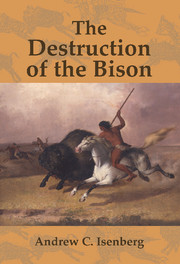Introduction
Published online by Cambridge University Press: 05 August 2012
Summary
Before Europeans brought the horse to the New World, Native Americans in the Great Plains hunted bison from foot. Their technique was ingenious: by making a fire or creating a ruckus near a herd of bison, they stampeded the skittish animals toward a bluff. The Indians lined the route to the bison “jump” with fallen trees or thicket and waved robes to shoo the beasts toward their destination. If the hunters dared to risk a general conflagration, they set more fires to direct the herd. Once they had stampeded the bison over the precipice, they peppered the crippled animals with arrows. For the bison, the stampede to the bluff was probably a disorienting experience. As they hurried toward their deaths, the more perceptive among them might have wondered, “Where is all this commotion leading me?” As readers of this book consider – among other things – grassland ecology, horses, smallpox, the fur trade, and gender roles in Indian and Euroamerican societies, they may find themselves pondering the same question. Nonetheless, just as pedestrian hunters herded their prey to their deaths, this book eventually leads to the destruction of the bison.
Why consider so many seemingly disparate subjects? Because, a host of economic, cultural, and ecological factors herded the bison toward their near-extinction. That diverse assembly of factors first emerged in the middle of the eighteenth century from ongoing encounters among Indians, Euroamericans, and the Great Plains environment.
- Type
- Chapter
- Information
- The Destruction of the BisonAn Environmental History, 1750–1920, pp. 1 - 12Publisher: Cambridge University PressPrint publication year: 2000

